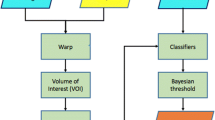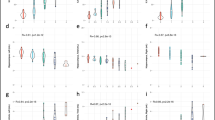Abstract
Purpose
This study aims to investigate hippocampal subfield volumes in patients with hippocampal sclerosis (HS) without visually detectable MRI abnormalities and to determine the diagnostic accuracy using hippocampal subfield volumes.
Materials and methods
We examined 46 patients with unilateral HS who had a histopathological diagnosis, and 54 controls. The patients were divided into two groups; visually detectable HS (n = 26) and undetectable HS (n = 20) on MRI. The volumes of hippocampal subfield using FreeSurfer were compared among the three groups. Diagnostic accuracy was calculated as the AUC of ROC using cutoff values for each individual subfield.
Results
Compared with the controls, visually detectable HS showed significantly reduced volumes of all the hippocampal subfields and entire hippocampus, whereas visually undetectable HS showed significant atrophy only in the CA3 and hippocampus-amygdala-transition-area. To diagnose visually undetectable HS, the CA3 volumes had AUC of 0.719, which was higher than AUC of 0.614 based on the entire hippocampal volumes.
Conclusion
Visually undetectable HS demonstrated volume reductions in the CA3. Further, the CA3 volumes was more useful to diagnose visually undetectable HS compared with the entire hippocampal volumes.



Similar content being viewed by others

Abbreviations
- CA:
-
Cornu ammonis
- GC-DG:
-
Granule cell layer of dentate gyrus
- HS:
-
Hippocampal sclerosis
- HSV:
-
Hippocampal subfield volumetry
- ILEA:
-
International league against epilepsy
- MTLE:
-
Mesial temporal lobe epilepsy
- SD:
-
Standard deviation
References
Berkovic SF, Andermann F, Olivier A, Ethier R, Melanson D, Robitaille Y, et al. Hippocampal sclerosis in temporal lobe epilepsy demonstrated by magnetic resonance imaging. Ann Neurol. 1991;29(2):175–82.
Bronen RA, Fulbright RK, Kim JH, Spencer SS, Spencer DD, Al-Rodhan N. Regional distribution of MR findings in hippocampal sclerosis. Am J Neuroradiol. 1995;16(6):1193–200.
Hanamiya M, Korogi Y, Kakeda S, Ohnari N, Kamada K, Moriya J, et al. Partial loss of hippocampal striation in medial temporal lobe epilepsy: pilot evaluation with high-spatial-resolution T2-weighted MR imaging at 3.0 T. Radiology. 2009;251(3):873–81.
Jack CR Jr, Rydberg CH, Krecke KN, Trenerry MR, Parisi JE, Rydberg JN, et al. Mesial temporal sclerosis: diagnosis with fluid-attenuated inversion-recovery versus spin-echo MR imaging. Radiology. 1996;199(2):367–73.
Jackson G, Kuzniecky R, Cascino GD. Hippocampal sclerosis without detectable hippocampal atrophy. Neurology. 1994;44(1):42.
Mathern GW, Pretorius JK, Babb TL. Quantified patterns of mossy fiber sprouting and neuron densities in hippocampal and lesional seizures. J Neurosurg. 1995;82(2):211–9.
De Lanerolle NC, Kim JH, Williamson A, Spencer SS, Zaveri HP, Eid T, et al. A retrospective analysis of hippocampal pathology in human temporal lobe epilepsy: evidence for distinctive patient subcategories. Epilepsia. 2003;44(5):677–87.
Proper E, Jansen G, Van Veelen C, Van Rijen P, Gispen W, De Graan P. A grading system for hippocampal sclerosis based on the degree of hippocampal mossy fiber sprouting. Acta Neuropathol. 2001;101(4):405–9.
Thom M, Zhou J, Martinian L, Sisodiya S. Quantitative post-mortem study of the hippocampus in chronic epilepsy: seizures do not inevitably cause neuronal loss. Brain. 2005;128(6):1344–57.
Meencke H, Veith G, Lund S. Bilateral hippocampal sclerosis and secondary epileptogenesis. Epilepsy Res Suppl. 1995;12:335–42.
Blümcke I, Thom M, Aronica E, Armstrong DD, Bartolomei F, Bernasconi A, et al. International consensus classification of hippocampal sclerosis in temporal lobe epilepsy: a Task Force report from the ILAE Commission on Diagnostic Methods. Epilepsia. 2013;54(7):1315–29.
Thom M. Hippocampal sclerosis in epilepsy: a neuropathology review. Neuropathol Appl Neurobiol. 2014;40(5):520–43.
Na M, Ge H, Shi C, Shen H, Wang Y, Pu S, et al. Long-term seizure outcome for international consensus classification of hippocampal sclerosis: a survival analysis. Seizure. 2015;25:141–6.
Jovicich J, Czanner S, Greve D, Haley E, van der Kouwe A, Gollub R, et al. Reliability in multi-site structural MRI studies: effects of gradient non-linearity correction on phantom and human data. NeuroImage. 2006;30(2):436–43.
Sled JG, Zijdenbos AP, Evans AC. A nonparametric method for automatic correction of intensity nonuniformity in MRI data. IEEE Trans Med Imag. 1998;17(1):87–97.
Van Leemput K, Bakkour A, Benner T, Wiggins G, Wald LL, Augustinack J, et al. Automated segmentation of hippocampal subfields from ultra-high resolution in vivo MRI. Hippocampus. 2009;19(6):549–57.
Iglesias JE, Augustinack JC, Nguyen K, Player CM, Player A, Wright M, et al. A computational atlas of the hippocampal formation using ex vivo, ultra-high resolution MRI: application to adaptive segmentation of in vivo MRI. Neuroimage. 2015;115:117–37.
Goubran M, Bernhardt BC, Cantor-Rivera D, Lau JC, Blinston C, Hammond RR, et al. In vivo MRI signatures of hippocampal subfield pathology in intractable epilepsy. Hum Brain Mapp. 2016;37(3):1103–19.
Schoene-Bake JC, Keller SS, Niehusmann P, Volmering E, Elger C, Deppe M, et al. In vivo map** of hippocampal subfields in mesial temporal lobe epilepsy: relation to histopathology. Hum Brain Mapp. 2014;35(9):4718–28.
Sone D, Sato N, Maikusa N, Ota M, Sumida K, Yokoyama K, et al. Automated subfield volumetric analysis of hippocampus in temporal lobe epilepsy using high-resolution T2-weighed MR imaging. Neuroimage Clin. 2016;12:57–64.
Jardim AP, Corso JT, Garcia MT, Gaça LB, Comper SM, Lancellotti CL, et al. Hippocampal atrophy on MRI is predictive of histopathological patterns and surgical prognosis in mesial temporal lobe epilepsy with hippocampal sclerosis. Epilepsy Res. 2016;128:169–75.
Bernhardt BC, Bernasconi A, Liu M, Hong SJ, Caldairou B, Goubran M, et al. The spectrum of structural and functional imaging abnormalities in temporal lobe epilepsy. Ann Neurol. 2016;80(1):142–53.
Author information
Authors and Affiliations
Corresponding author
Additional information
Publisher's Note
Springer Nature remains neutral with regard to jurisdictional claims in published maps and institutional affiliations.
About this article
Cite this article
Masaki, H., Watanabe, K., Kakeda, S. et al. Hippocampal sclerosis without visually detectable hippocampal MRI abnormalities: automated subfield volumetric analysis. Jpn J Radiol 38, 1020–1027 (2020). https://doi.org/10.1007/s11604-020-01019-y
Received:
Accepted:
Published:
Issue Date:
DOI: https://doi.org/10.1007/s11604-020-01019-y



